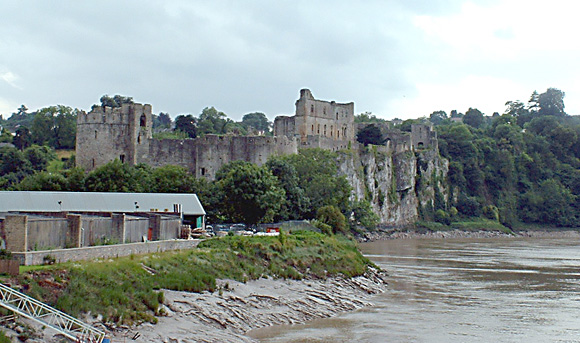| | | | | Welsh Icons
About Wales | and all things Welsh |
|
|
| Ariel View of Chepstow Castlet |
|  |
| | | Chepstow Castle, located in Chepstow on top of cliffs overlooking the River Wye, is the oldest surviving stone fortification in Britain. It was built under the instructions of the Norman lord William fitzOsbern from 1067, and was the southernmost of a chain of castles built along the English-Welsh border.
The speed with which William the Conqueror committed to the creation of a castle in Chepstow is testament to its strategic importance. At the time, the kingdoms in the area were independent of the English crown and the castle in Chepstow provided a way to suppress the Welsh from attacking Gloucestershire. It controlled an important crossing point on the River Wye, itself a major artery of communications to Monmouth and Hereford. The precipitous limestone cliffs beside the river, and a valley (the Dell) to the landward side, afforded an excellent defensive location.
The Great Tower was probably completed by about 1090. It was constructed in stone from the first (as opposed to wood, like most others built at this time), marking its importance as a defensive stronghold on the border between England and Wales. Further fortifications were added over the succeeding centuries by William Marshal and son around 1200, and by Roger Bigod III from the 1270s.
From the 14th century, and in particular the end of the wars between England and Wales in the early 15th century, its defensive importance declined. From the 16th century, the castle became more designed for occupation as a great house, though it was to see action again during the English Civil War, when it was held by the Royalists and besieged in 1645 and 1648. After the war, the castle was used as a prison. Its occupants included Bishop Jeremy Taylor, and Henry Marten, one of the commissioners who signed the death warrant of Charles I, who was imprisoned here before his death in 1680.
From 1690 onwards it was left to decay, and in the late 18th century its ruins became, with other sites in the Wye valley, a focus for tourists seeking views of the "picturesque".
In 1910/11, the castle and adjoining river bed were the site of well-publicised excavations by Dr Orville Ward Owen, who was attempting to find secret documents to prove that Shakespeare's plays had in fact been written by Francis Bacon. In 1913, the movie "Ivanhoe", starring King Baggot, was made in the grounds.
Chepstow Castle is open to the public and is now in the care of Cadw. |
|
| | |  Address: Address:
| Chepstow Castle
Bridge Street,
Chepstow,
Monmouthshire NP16 5EZ |  Telephone: Telephone:
| 01291 624065 |  Website: Website:
| http://www.cadw.wales.gov.uk/default.asp?id=6&PlaceID=50 |  Admission Charge:- Admission Charge:-
| Adult - £3.50, Concession - £3.00, Family - £10.00 |  Hours: Hours:
| Spring Opening Times:
1.04.06 - 31.05.06: 9.30 - 17.00
Summer Opening Times:
1.06.06 - 30.09.06: 9.30 - 18.00
Autumn Opening Times:
1.10.06 - 31.10.06: 9.30 - 17.00
Winter Opening Times:
1.11.06 - 31.03.07: 9.30 -16.00 Monday - Saturday,
11.00 - 16.00 Sunday
Most sites are closed on 24, 25 and 26 December and 1 January. |  Facilities for the Disabled: Facilities for the Disabled:
| The path to the entrance is solid but is quite long and steep, without flat resting places. There are three steps to the ticket office and shop. Access to the castle from the exhibition area, is gained by permission of the keeper, through the gates at the side of the entrance. Within the walls there are cobbled paths and there are uneven paths on a slope to the lower, central and higher bails. There are information panels and exhibition areas. Benches provided.
A pay-and-display car park is situated near the entrance with four spaces reserved for the disabled.
The public toilets in the car park include a Radar key toilet.
Disabled visitors and their assisting companion will be admitted free of charge to all monuments. Please note that, for health reasons, dogs are not allowed on Cadw sites, but guide dogs and hearing dogs for the deaf are welcome. |
|
| All copyrights acknowledged with thanks to Wikipedia. Another site by 3Cat Design 2006-2007
Whilst we try to give accurate information, we accept no liabilty for loss or incorrect information listed on this site.
If you do spot a mistake, please let us know.
Email: [email protected] |
| |







